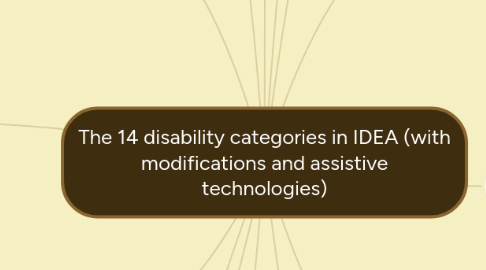The 14 disability categories in IDEA (with modifications and assistive technologies)
作者:Chris D

1. Multiple Disabilities
1.1. Description: Aconcomitant [simultaneous] impairments (such as intellectual disability-blindness, intellectual disability-orthopedic impairment, etc.), the combination of which causes such severe educational needs that they cannot be accommodated in a special education program solely for one of the impairments. The term does not include deaf-blindness.
1.2. Modifications: Varied
2. Orthopedic impairment
2.1. Description: This means a severe orthopedic impairment but doesn’t include impairments caused by a congenital anomaly, impairments caused by disease (e.g., poliomyelitis, bone tuberculosis), and impairments from other causes (e.g.,cerebral palsy, amputations, and fractures or burns that cause contractures).
2.2. Modifications: Allowing physical therapist to be present, carefully considering the condition for any physical activities
2.3. Case Study:
2.4. Assistive Technology: speech recognition software, devices for positiong and mobility
3. Other health impairments
3.1. Description: Means having limited strength, vitality, or alertness, including a heightened alertness to environmental stimuli, that results in limited alertness with respect to the educational environment, that is due to chronic or acute health problems such as asthma, attention deficit disorder or attention deficit hyperactivity disorder, diabetes, epilepsy, a heart condition, hemophilia, lead poisoning, leukemia, nephritis, rheumatic fever, sickle cell anemia, and Tourette syndrome.
3.2. Modifications: Depends on the impairment. For ADHD allow students to move around. For health issues allow students to see nurse whenever. For asthma allow students to sit out physical activities.
3.3. Assistive Technology: iPad apps
4. Specific Learning Disability
4.1. Description: A disorder in one or more of the basic psychological processes involved in understanding or in using language, spoken or written, that may manifest itself in the imperfect ability to listen, think, speak, read, write, spell, or to do mathematical calculations.
4.2. Modifications: Modify assignments depending on the disability.
4.3. Assistive Technology: spellchecker, apps to help students with reading. Writing, dyslexia, dyscalculia.
5. Speech or Language Impairment
5.1. Description: A communication disorder such as stuttering, impaired articulation, a language impairment, or a voice impairment that adversely affects a child’s educational performance.
5.2. Modifications: Allow to not present in front of people; provide choice for activities.
5.3. Assistive Technology: Big talks
6. Traumatic Brain Injury
6.1. Description: An acquired injury to the brain caused by an external physical force, resulting in total or partial functional disability or psychosocial impairment, or both.
6.2. Modifications: Permit a note-taker, adjust instruction
6.3. Assistive Technology: Visual Assistant microcomputer
7. Visual impairment including blindness
7.1. Description: An impairment in vision that, even with correction, adversely affects a child’s educational performance. The term includes both partial sight and blindness.
7.2. Modifications: Provide descriptions of pictures
7.3. Case Study:
7.4. Assistive Technology: speech to text technology
8. Autism
8.1. Description: A developmental disability significantly affecting verbal and nonverbal communication and social interaction, generally evident before age three, that adversely affects a child’s educational performance.
8.2. Modifications: provide pictures a child can use in answering questions if communication is difficult, role-playing social situations, scaffolding assignments.
8.3. Assistive Technology: MyVoice
9. Deaf-Blindness
9.1. Description: A simultaneous hearing and visual impairments, the combination of which causes such severe communication and other developmental and educational needs.
9.2. Modifications: Small group instruction with a special education teacher using assistive technology.
9.3. Case Study:
9.4. Assistive Technology: alphabet gloves, tellatouch
10. Deafness
10.1. Description: A hearing impairment so severe that a child is impaired in processing linguistic information through hearing, with or without amplification
10.2. Modifications: Allowing for a personal assistant fluent in ASL. Allowing more time to complete assignments.
10.3. Assistive technology: personal amplified system
11. Developmental Delay
11.1. Description: A delay in one or more of the following areas: physical development; cognitive development; communication; social or emotional development; or adaptive development.
11.2. Modifications: For emotional delay provide rubrics for behaviours, be consistent with classroom rules, role-play of model behavious. For mental delay provide hands on activities, a peer mentor, place the student near the front. For physical delay use assistive technology.
11.3. Assistive Technology: Radio Shack Talking Watch, The planning and execution trainer (PEAT)
12. Emotional Disturbance
12.1. Description: A condition exhibiting one or more of the following characteristics over a long period of time and to a marked degree that adversely affects a child’s educational performance.
12.2. Modifications: Allow more time for task completion, allow student to pick his/her own groups for group activities.
12.3. Assistive Technology: iPod to help student tune in
13. Hearing Impairment
13.1. Description: An impairment in hearing, whether permanent or fluctuating, assistants, does not include “deafness”.
13.2. Modifications: Assistants with ASL and note-takers, computers made for hearing-impared.
13.3. Assistive Technology: see Deafness
14. Intellectual Disability
14.1. Description: Significantly sub-average general intellectual functioning, existing concurrently [at the same time] with deficits in adaptive behavior and manifested during the developmental period.
14.2. Modifications: Quiet working space, high repetition, educational assistant.
14.3. Assistive Technology: rewordify, iReadWrite
15. Source:


